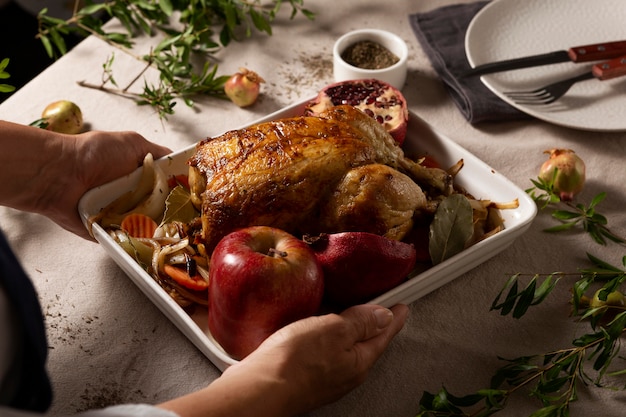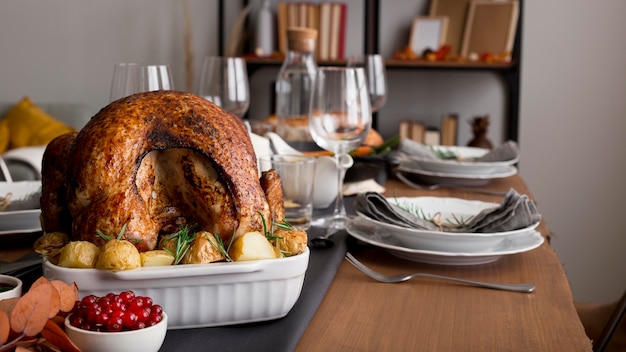It's that time of year again - the time when the scent of roasting turkey fills the air and the promise of a delicious feast hangs heavy in the atmosphere. But for many, the anticipation of Thanksgiving or Christmas dinner is mixed with a bit of anxiety. "How long do I roast this turkey?" they wonder. "Will it be cooked through? Will it be dry? Will it be a disaster?!" Well, I'm here to tell you: relax. Roasting a 20-pound turkey doesn't have to be a stressful ordeal. It can be a wonderfully enjoyable experience, a testament to your culinary skills, and a source of pride for you and your family.
(Part 1) The Importance of Patience

First things first: let's get one thing straight: roasting a turkey is not a quick task. It takes time, patience, and a bit of know-how. You can't just chuck it in the oven and expect a masterpiece. It's a bit like baking a cake: you need to give it time to cook through properly and develop its full flavour potential. Imagine a cake that's only half-baked - not very appealing, is it? The same principle applies to your turkey.
The Turkey's Temperature is Key
The key to a delicious turkey is to cook it to the right internal temperature. The USDA recommends an internal temperature of 165°F for the thickest part of the thigh, ensuring the turkey is safe to eat and cooked to perfection. You can use a meat thermometer to check this, and trust me, it's a lifesaver. I've learned the hard way that relying on the timer alone isn't enough. Imagine biting into a seemingly cooked turkey only to discover it's still a bit pink inside – not a pleasant experience!
Let's Talk About Resting
Here's another crucial tip: once the turkey is cooked, let it rest for at least 15 minutes before carving. Think of it as a little spa treatment for your turkey. This allows the juices to redistribute, resulting in a more succulent and moist turkey. It's like letting a good wine breathe - it enhances its flavour. I know it's tempting to dive right in and start carving, but trust me, the wait is worth it.
(Part 2) Roast Time: The Big Question

Now, you're probably wondering: "Okay, so how long do I actually roast this 20-pound turkey?" It's not a straightforward answer, and it depends on a few factors. It's a bit like trying to find the perfect recipe – each turkey is unique, and its cooking time will vary accordingly.
Size Matters:
Obviously, a bigger turkey takes longer to cook than a smaller one. Your 20-pound turkey is a hefty beast, so expect a longer roasting time than a smaller bird. It's like baking a giant loaf of bread – it needs more time to bake through.
Oven Temperature:
Your oven's temperature also plays a role. Most recipes recommend roasting at 325°F (160°C), but you can go a bit hotter if you prefer a crispier skin. Just remember that higher temperatures can lead to faster cooking, so you'll need to monitor your turkey closely.
Stuffing or No Stuffing:
Are you stuffing the turkey? This can also affect roasting time. stuffed turkeys need a slightly longer cooking time to ensure the stuffing is cooked through. The stuffing essentially creates a barrier inside the turkey, slowing down the cooking process.
(Part 3) turkey roasting Time Chart

I know all this talk about roasting times can be a bit confusing. It's like deciphering an ancient code! That's why I've created a handy table that might help you get a better idea.
| turkey weight | Unstuffed Roasting Time | Stuffed Roasting Time |
|---|---|---|
| 10-12 pounds | 2-2.5 hours | 3-3.5 hours |
| 12-14 pounds | 2.5-3 hours | 3.5-4 hours |
| 14-16 pounds | 3-3.5 hours | 4-4.5 hours |
| 16-18 pounds | 3.5-4 hours | 4.5-5 hours |
| 18-20 pounds | 4-4.5 hours | 5-5.5 hours |
| 20-22 pounds | 4.5-5 hours | 5.5-6 hours |
Remember: this is just a general guideline. Your turkey might require a bit more or less time depending on your oven, the turkey's size, and other factors. It's always best to err on the side of caution and check the internal temperature to ensure it's cooked through.
(Part 4) The Art of Basting
Okay, now let's talk about basting. It's an essential step to ensure a juicy and flavorful turkey. Basting involves spooning pan juices over the turkey throughout the cooking process. It helps to keep the turkey moist and adds a beautiful golden-brown color. It's like giving your turkey a little massage, keeping it hydrated and happy.
Basting Frequency:
There's no hard and fast rule about how often to baste. I typically baste every 30-45 minutes, but you can adjust based on your preference. Just remember, the more you baste, the more flavorful and juicy your turkey will be.
What to Use for Basting:
You can use pan juices, butter, or a mixture of both for basting. I like to use a combination of pan juices and melted butter for a rich and flavorful finish. It's like adding a touch of luxury to your turkey.
The Importance of a Good roasting pan:
Speaking of pan juices, make sure you use a good roasting pan that allows the juices to pool at the bottom. This makes it easier to baste and helps to keep the turkey moist. Imagine a pan that doesn't hold the juices well – it's like trying to water a plant with a leaky bucket!
(Part 5) Choosing the Right Turkey
Before you even start thinking about roasting time, you need to choose the right turkey. It's like choosing the perfect ingredient for your culinary masterpiece.
Fresh vs. Frozen:
First, decide if you want a fresh or frozen turkey. Fresh turkeys are great if you can find them, but they require a bit more planning. Frozen turkeys are more readily available and give you some flexibility. Just remember to thaw them properly before roasting. No one wants to deal with a partially frozen turkey in the middle of their cooking!
Size Matters Again:
I've already mentioned this, but it bears repeating. Choose a turkey that's the right size for your group. A 20-pound turkey is perfect for a large gathering, but if you're only cooking for a small family, a smaller turkey will do. No one wants to be left with a mountain of leftover turkey!
Look for Quality:
When choosing your turkey, look for one with plump breasts and drumsticks. The skin should be smooth and unblemished. And remember, a good turkey is the foundation for a delicious meal.
(Part 6) The Prep Work: It's All About the Details
Before you even think about putting the turkey in the oven, there's some prep work to be done. This is where you can get creative and personalize your turkey. Think of it as adding your own special touch to your masterpiece.
Brining:
Brining is a technique that involves soaking the turkey in a salt-water solution to keep it moist and flavorful. It's not essential, but it's a great way to add flavor and tenderness. I've tried brining and I'll admit, it makes a difference. It's like giving your turkey a spa treatment!
Stuffing:
Are you stuffing the turkey? This is a classic Thanksgiving tradition, but it does come with some risks. Stuffed turkeys need to be cooked to a higher temperature to ensure the stuffing is cooked through. If you're planning on stuffing your turkey, make sure you're aware of the safety guidelines. It's better to be safe than sorry!
Seasoning:
Don't forget about seasoning! A good rub can really enhance the flavor of your turkey. I like to use a simple combination of salt, pepper, garlic powder, and onion powder. But feel free to get creative and add your favorite herbs and spices. It's your turkey, so make it your own!
(Part 7) Monitoring the Turkey: The Importance of Patience (Again!)
Once your turkey is in the oven, the real work begins: monitoring. Patience is key here! It's like watching a delicate flower bloom – it needs time and care.
The Thermometer is Your Best Friend:
I've already mentioned the importance of using a meat thermometer to check the internal temperature of the turkey. You'll need to check it several times throughout the cooking process to ensure it's cooking evenly. Think of it as checking your baking progress – you wouldn't want to open the oven every five minutes, but you need to check in occasionally to make sure things are on track.
Dealing with Hot Spots:
Ovens can sometimes have hot spots, so rotate the turkey halfway through cooking to ensure even browning. And don't forget to baste! It's like giving your turkey a little extra attention to make sure it cooks perfectly.
Don't Open the Oven Too Often:
Every time you open the oven door, you lose heat, which can affect the cooking time. Try to limit the number of times you open the oven to check on the turkey. It's like letting your cake bake undisturbed – too much interference can disrupt the process.
(Part 8) Carving the Turkey: A Moment of Triumph
After all that time and effort, it's finally time to carve the turkey. This is the moment of truth! It's like revealing your culinary masterpiece to the world.
Rest is Key:
Remember to let the turkey rest for at least 15 minutes before carving. This allows the juices to redistribute and makes carving easier. It's like giving your turkey a chance to relax and settle down after its long journey in the oven.
Sharp Knife is Essential:
Use a sharp knife for carving. It will make the process smoother and prevent tearing the meat. Think of it as using a surgeon's scalpel – precise and efficient.
Presentation Matters:
Carving is not just about cutting the turkey; it's also about presentation. Arrange the turkey beautifully on a platter and enjoy the fruits of your labor. It's like displaying a work of art for all to admire.
(Part 9) Leftover Magic: Don't Waste a Bite!
After all that feasting, you're bound to have some leftover turkey. Don't let it go to waste! It's an opportunity to get creative and enjoy the deliciousness even longer.
turkey sandwiches:
Turkey sandwiches are a classic way to use up leftovers. Add some cranberry sauce, mayonnaise, and a slice of cheese for a delicious and satisfying meal. It's a quick and easy way to enjoy your turkey leftovers.
turkey soup:
Turkey soup is another great way to use up leftovers. You can make a simple broth with the turkey bones and then add the turkey meat, vegetables, and noodles. It's a comforting and warming dish perfect for chilly evenings.
turkey salad:
Turkey salad is a versatile dish that can be enjoyed on sandwiches, crackers, or lettuce wraps. Combine chopped turkey with mayonnaise, celery, onion, and your favorite seasonings. It's a light and refreshing way to enjoy your turkey leftovers.
(Part 10) FAQs
Q1: How do I know if my turkey is done?
A1:
The best way to tell if your turkey is done is to check the internal temperature with a meat thermometer. Insert the thermometer into the thickest part of the thigh, avoiding the bone. The turkey is done when the internal temperature reaches 165°F (74°C). It's like checking your cake with a toothpick – it should come out clean.Q2: Can I overcook a turkey?
A2:
Yes, you can overcook a turkey. Overcooked turkey will be dry and tough. To avoid overcooking, make sure you check the internal temperature regularly and don't cook it for longer than recommended. It's like baking a cake – you don't want to overbake it and end up with a dry, crumbly mess.Q3: What should I do if my turkey isn't cooked through?
A3:
If your turkey isn't cooked through, you'll need to continue cooking it until it reaches the safe internal temperature of 165°F (74°C). You can check the temperature every 10-15 minutes. It's like finishing off your baking – you need to make sure everything is cooked through properly.Q4: Can I roast a turkey in a slow cooker?
A4:
It's not recommended to roast a turkey in a slow cooker. Slow cookers are not designed to cook large pieces of meat like a whole turkey. The turkey might not cook evenly and could be undercooked. It's like trying to fit a square peg in a round hole – it's not the right tool for the job.Q5: Can I freeze leftover turkey?
A5:
Yes, you can freeze leftover turkey. Wrap it tightly in plastic wrap or aluminum foil and freeze for up to 3 months. It's like preserving a piece of your culinary masterpiece for later enjoyment.Everyone is watching

Corn on the Cob: The Ultimate Guide to Perfectly Cooked Ears
Healthy MealsAh, corn on the cob. Just the name evokes images of sunny days, barbecues, and that sweet, juicy flavour that ...

Perfect Pork Roast Oven Cooking Time: A Guide to Delicious Results
Healthy MealsThere's something truly satisfying about a perfectly roasted pork. The aroma alone is enough to make your mout...

Ham Cooking Time: How Long to Bake, Smoke, or Boil a Delicious Ham
Healthy MealsAh, ham. It's a classic, isn't it? A real crowd-pleaser, especially around holidays. And when done right, it'...

Scallops: The Ultimate Guide to Perfect Cooking
Healthy MealsAh, scallops. Those delicate, sweet, and utterly delicious morsels of the sea. They hold a special place in my...

Spaghetti Squash: The Ultimate Guide to Cooking and Serving
Healthy MealsRemember that time you saw spaghetti squash at the supermarket, looking all bumpy and strange, and thought, "W...
